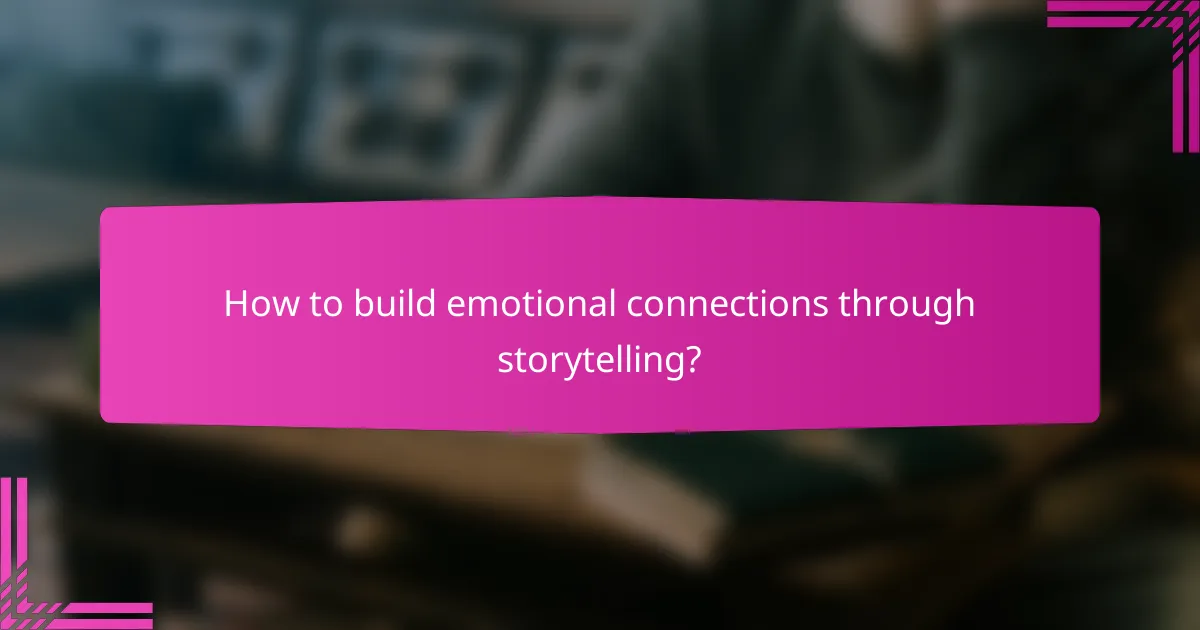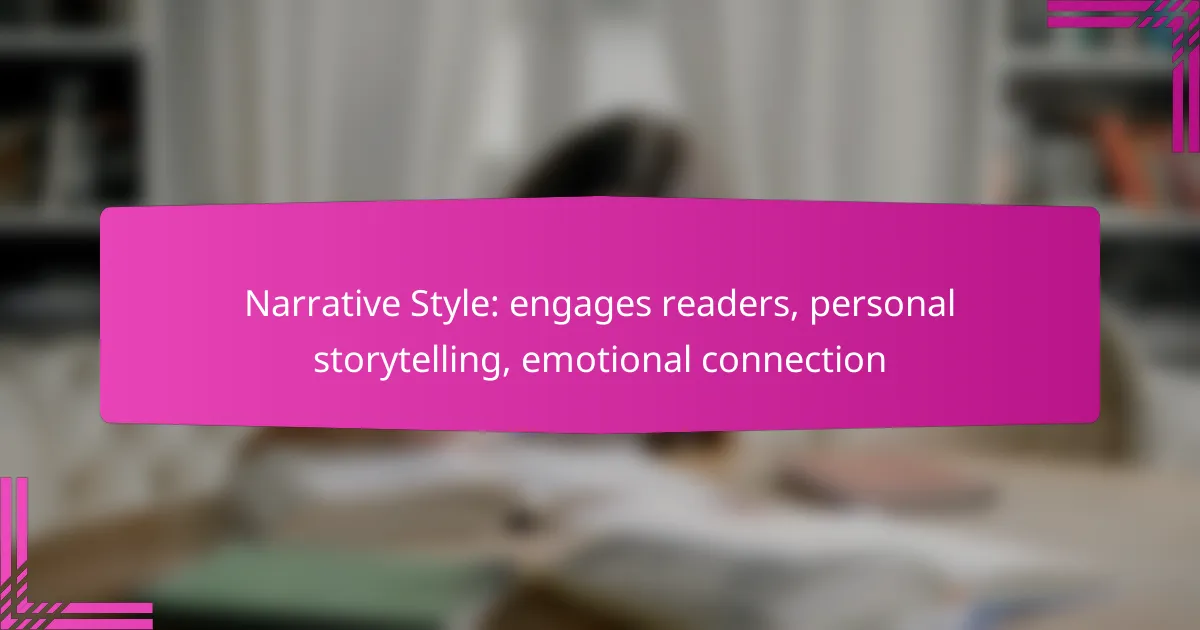Narrative style plays a crucial role in engaging readers by intertwining personal stories that evoke emotional and cultural resonance. By employing techniques like first-person perspectives and vivid imagery, storytellers can create authentic connections that foster understanding and empathy, inviting readers to immerse themselves in relatable experiences.

How can narrative style engage readers in Australia?
Narrative style can significantly engage readers in Australia by weaving personal stories that resonate emotionally and culturally. This approach invites readers to connect with the content on a deeper level, fostering a sense of belonging and understanding.
Personal storytelling techniques
Personal storytelling techniques involve sharing experiences that reflect genuine emotions and relatable situations. By using first-person perspectives, writers can create a more intimate atmosphere, allowing readers to feel as if they are part of the journey.
Consider using anecdotes that highlight challenges and triumphs. This method not only captivates the audience but also encourages them to reflect on their own experiences, enhancing engagement.
Creating emotional connections
Creating emotional connections is essential for engaging readers. Writers can achieve this by tapping into universal themes such as love, loss, and resilience. When readers see their own feelings mirrored in a narrative, they are more likely to invest in the story.
Utilizing vivid imagery and descriptive language can evoke strong emotions. For instance, describing a heartfelt reunion or a moment of despair can resonate deeply, making the narrative more impactful.
Using relatable characters
Using relatable characters is crucial for engaging readers. Characters that reflect the diversity of Australian society, including various backgrounds and experiences, can help readers see themselves in the story. This relatability fosters a stronger connection to the narrative.
Writers should develop characters with distinct personalities and flaws, making them more human and accessible. Readers are drawn to characters who face challenges similar to their own, enhancing the overall engagement with the story.
Incorporating local culture
Incorporating local culture enriches narratives and makes them more relevant to Australian readers. By referencing local customs, slang, and landmarks, writers can create a sense of place that resonates with the audience.
For example, mentioning iconic Australian events or traditions can evoke a shared cultural identity. This connection not only engages readers but also fosters a sense of pride and belonging within the narrative.

What are effective personal storytelling methods?
Effective personal storytelling methods engage readers by creating an emotional connection through relatable experiences. Techniques such as using a first-person perspective, vivid imagery, and incorporating conflict and resolution can significantly enhance the impact of your narrative.
First-person perspective
Using a first-person perspective allows readers to experience the story through your eyes, fostering a deeper emotional connection. This approach makes the narrative feel more intimate and authentic, as it reflects personal thoughts and feelings directly.
When employing this method, focus on sharing your emotions and reactions to events. For instance, instead of saying “I was nervous,” describe the physical sensations and thoughts that accompanied that feeling, such as “My heart raced, and my palms felt clammy.” This specificity draws readers into your experience.
Vivid imagery and descriptions
Vivid imagery and detailed descriptions help paint a picture in the reader’s mind, making the story more engaging. By using sensory details, you can evoke emotions and create a stronger connection to the narrative.
Consider incorporating metaphors and similes to enhance your descriptions. For example, instead of saying “the sunset was beautiful,” you might say “the sunset spilled vibrant oranges and pinks across the sky like a painter’s brush.” This technique enriches the storytelling experience and captivates the audience.
Conflict and resolution
Conflict and resolution are essential elements of storytelling that create tension and drive the narrative forward. Presenting a challenge or obstacle allows readers to invest emotionally in the outcome, making the resolution more satisfying.
When crafting your story, clearly define the conflict and explore its implications. For example, if you faced a career setback, describe the feelings of doubt and frustration you experienced. Then, illustrate the steps you took to overcome this challenge, highlighting personal growth and lessons learned. This structure not only engages readers but also provides them with relatable insights.

How to build emotional connections through storytelling?
Building emotional connections through storytelling involves sharing authentic experiences that resonate with your audience. By being genuine and relatable, you create a bond that fosters understanding and empathy.
Authenticity and vulnerability
Authenticity in storytelling means being true to yourself and your experiences. When you share your genuine thoughts and feelings, it invites others to connect with you on a deeper level. Vulnerability, such as admitting fears or failures, can strengthen this bond.
For example, a personal story about overcoming a challenge can inspire others facing similar situations. This openness encourages trust and makes your narrative more compelling.
Shared experiences
Shared experiences create a sense of community and belonging. When you tell stories that reflect common struggles or joys, your audience feels understood and connected. This can be particularly powerful in diverse groups where individuals may have different backgrounds but similar emotions.
Consider using relatable scenarios, such as family gatherings or workplace challenges, to illustrate your points. These familiar situations can evoke memories and emotions that resonate with your listeners.
Evoking empathy
Evoking empathy involves crafting narratives that allow your audience to step into someone else’s shoes. By highlighting the emotions and motivations of characters in your story, you can foster a deeper understanding of their experiences.
Utilize descriptive language and vivid imagery to paint a picture of the situation. For instance, sharing a story about a difficult decision can help your audience feel the weight of that choice, enhancing their emotional connection to the narrative.

What criteria should be considered for narrative style?
When developing a narrative style, consider the target audience and the clarity of your purpose and message. These criteria help create engaging stories that resonate emotionally with readers.
Target audience understanding
Understanding your target audience is crucial for effective narrative style. Consider their demographics, interests, and preferences to tailor your storytelling approach. For instance, a narrative aimed at young adults may incorporate contemporary slang and relatable experiences, while a story for a professional audience might focus on industry-specific challenges.
To gauge audience understanding, conduct surveys or engage in social media discussions. This feedback can guide your tone, vocabulary, and themes, ensuring that your narrative connects meaningfully with readers.
Purpose and message clarity
Clarity of purpose and message is essential in narrative style. Define the core message you want to convey and ensure that every element of your story supports this goal. A clear purpose helps maintain focus and prevents the narrative from drifting into unrelated topics.
Use straightforward language and structure to enhance message clarity. For example, if your narrative aims to inspire action, incorporate strong calls to action and relatable anecdotes that illustrate your point. Avoid jargon unless it serves a specific purpose for your audience.

What are the benefits of using narrative style in marketing?
Narrative style in marketing creates a compelling way to connect with audiences by telling stories that resonate emotionally. This approach not only captures attention but also fosters a deeper understanding of the brand’s values and offerings.
Increased audience engagement
Using narrative style significantly boosts audience engagement by making content relatable and memorable. When stories are woven into marketing messages, they draw readers in, encouraging them to invest time and attention. For instance, a brand sharing a customer’s journey can evoke empathy and interest, leading to longer interaction times.
To maximize engagement, focus on authentic storytelling that reflects real experiences. Avoid overly polished narratives that may feel disingenuous; instead, aim for a conversational tone that invites participation.
Higher conversion rates
Narrative style can lead to higher conversion rates by creating an emotional connection that influences purchasing decisions. When consumers relate to a story, they are more likely to trust the brand and feel motivated to take action, such as making a purchase or signing up for a newsletter.
Incorporate clear calls to action within your narratives to guide readers toward the next steps. For example, after sharing a success story, include a prompt to explore related products or services, making it easy for the audience to engage further.
Brand loyalty development
Developing brand loyalty through narrative style hinges on building a strong emotional bond with customers. When brands consistently share stories that align with their audience’s values and experiences, they cultivate a sense of community and belonging.
To foster loyalty, regularly engage your audience with fresh narratives that highlight customer experiences, brand missions, or social impact initiatives. This ongoing connection encourages repeat interactions and strengthens the overall relationship between the brand and its customers.

What tools can enhance narrative storytelling?
Several tools can significantly enhance narrative storytelling by improving visuals, structure, and engagement. Utilizing the right tools allows storytellers to create a more immersive experience for their audience.
Canva for visuals
Canva is a user-friendly graphic design platform that helps storytellers create stunning visuals to complement their narratives. With a wide range of templates, images, and design elements, it allows users to produce professional-quality graphics without needing extensive design skills.
When using Canva, consider the type of visuals that best support your story. Infographics, social media posts, and presentations can enhance understanding and retention of the narrative. For example, using a visually appealing infographic can summarize key points effectively, making complex information more digestible.
To maximize Canva’s potential, focus on consistency in color schemes and fonts that reflect your narrative’s tone. Avoid cluttered designs that can distract from the message. A good practice is to limit the number of colors to three or four and ensure that text is legible against the background.



